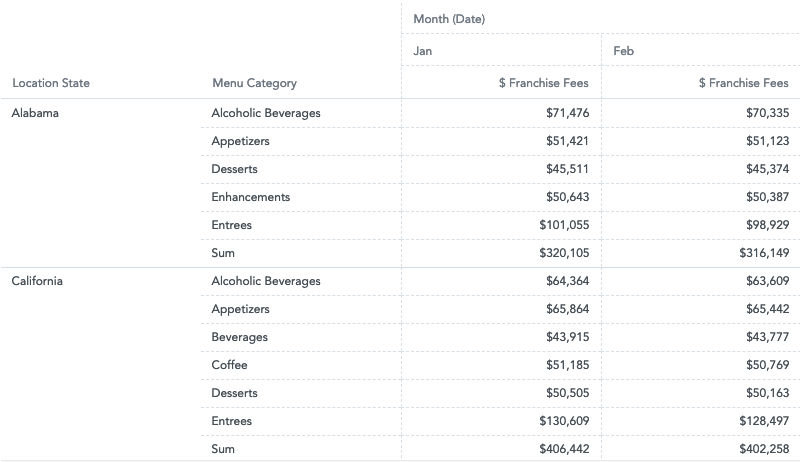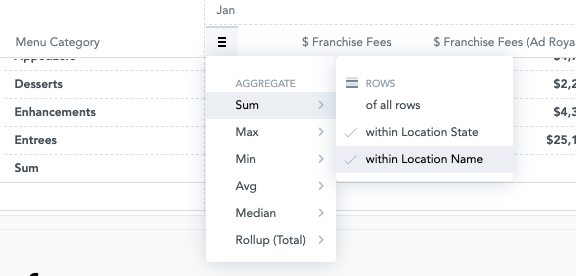Pivot Table
Pivot table component expands capabilities of a regular (flat) table by allowing you to reorganize and summarize selected data beyond the typical row-column relationship.
In GoodData.UI, a pivot table allows you to break measures into columns by setting attributes in the columns prop. You can also choose to display only attributes (without any measures). On the other hand, a flat table cannot display attributes in columns.
Compared to charts, pivot tables have higher limits for the number of datapoints to display.
The following pivot table shows franchise fees (a measure), which are split down by location state (an attribute) horizontally and by month (a column attribute) vertically.

Structure
import '@gooddata/react-components/styles/css/main.css';
import { PivotTable } from '@gooddata/react-components';
<PivotTable
projectId={<workspace-id>}
measures={<measures>}
sdk={<sdk>}
…
/>
Examples
Pivot table
The following code sample shows an arrangement for a typical pivot table.
const measures = [
{
measure: {
localIdentifier: 'franchiseFees',
definition: {
measureDefinition: {
item: {
identifier: franchiseFeesIdentifier
}
}
},
format: '#,##0'
}
}
];
const columns = [
{
visualizationAttribute: {
displayForm: {
identifier: monthDateIdentifier
},
localIdentifier: 'month'
}
}
];
const rows = [
{
visualizationAttribute: {
displayForm: {
identifier: locationStateDisplayFormIdentifier
},
localIdentifier: 'location'
}
}
];
<div style={{ height: 300 }}>
<PivotTable
projectId={workspaceId}
measures={measures}
rows={rows}
columns={columns}
/>
</div>
Flat table
You can also use the pivot table component to create a regular (flat) table.
const measures = [
{
measure: {
localIdentifier: 'franchiseFees',
definition: {
measureDefinition: {
item: {
identifier: franchiseFeesIdentifier
}
}
},
format: '#,##0'
}
}
];
const rows = [
{
visualizationAttribute: {
displayForm: {
identifier: locationStateDisplayFormIdentifier
},
localIdentifier: 'location'
}
}
];
<div style={{ height: 300 }}>
<PivotTable
projectId={workspaceId}
measures={measures}
rows={rows}
columns={columns}
/>
</div>
Sorting in pivot tables
You can sort rows and attribute columns in any pivot table. Measures are always listed in the same order in which they were defined in the measures prop.
Important! Sorting must be applied to any column attribute that is used in the pivot table. For example, in the following table, you apply sorting to both the Franchise Fees (measure) and the Date (column attribute).
Example: Sorting by measure
// ...using Pivot Table Example
const sortBy = [
{
measureSortItem: {
direction: 'desc',
locators: [
{
attributeLocatorItem: {
attributeIdentifier: 'month',
element: monthDateIdentifierJanuary
}
},
{
measureLocatorItem: {
measureIdentifier: 'franchiseFeesIdentifier'
}
}
]
}
}
];
<div style={{ height: 300 }}>
<PivotTable
projectId={workspaceId}
measures={measures}
rows={rows}
columns={columns}
sortBy={sortBy}
/>
</div>
Grouping
By default, the same row attribute values in a column are grouped across the rows, which helps improve data readability in pivot tables. The header of the grouped columns is displayed at the top of the table even when you scroll through a long group.
The grouping is applied when the following conditions are both met:
- The table is sorted by the first row attribute (either in ascending or descending order).
- The table has two or more row attributes.

To disable grouping, set the groupRows property to false (see Properties).
Totals
You can display rows with aggregated measure data using the totals prop. For more information, see Specify Table Totals.
Alternatively, you can enable the menu through which you can turn on the totals and subtotals. For more information, see Configuration menu.

Maximum height
By default, the maximum hight is not specified, and the pivot table fills the whole container. If there is still some empty space within the container after all the rows have been displayed, and the table has a total specified, a gap may appear between the data and the total because the total row sticks to the bottom.
To avoid this gap, specify the maximum height of the table using the maxHeight prop. With the maxHeight set, the table is displayed as small as possible while not expanding beyond the maxHeight limit, thus avoiding the gap. For more information, see Configuration menu.
NOTE: The maxHeight must be specified in pixels. If you want your table to be responsive, consider using react-measure to derive the maxHeight value dynamically.
Column width resizing
Auto resizing
By default, the width of the columns is not set, and all columns have the same fixed width regardless of the actual content. To automatically resize the columns to fit their content, add the columnSizing prop and set it to defaultWidth: "viewport":
columnSizing: {
defaultWidth: "viewport"
}
- The size is calculated based on the content in the header of the column that represents the lowest level of the grouped attributes (see Grouping). If this is not applicable, the size is calculated based on the content in the header of the column with the measure name and the cells with the measure values.
- Only the columns that are visible during the initial rendering of the table are automatically resized to fit their content.
- New columns (that is, those that are shown after the initial render) are resized only if the table has not been vertically or horizontally scrolled. This is useful especially for responsive tables with a dynamic width.
- A change of attributes, measures, filters, or totals in the table is handled as a new table. After the change is made, the column size is re-calculated based on the new data.
- Scrolling horizontally or vertically and sorting values in a column do not affect the column width.
- If you manually adjust the column width, the adjusted width is preserved only temporarily and will be reset to the previously set value after the table is re-rendered.
- The maximum column width is 500 px.
Manual resizing
The manual resizing feature is in the beta stage.
To set the width of the columns, add the columnWidths prop to the columnSizing prop.
columnSizing: {
columnWidths: [
{
attributeColumnWidthItem: {
width: 100,
attributeIdentifier: 'day'
}
},
{
measureColumnWidthItem: {
width: 200,
locators: [
{
attributeLocatorItem: {
attributeIdentifier: 'month',
element: monthDateIdentifierJanuary
}
},
{
measureLocatorItem: {
measureIdentifier: 'franchiseFeesIdentifier'
}
}
]
}
}
]
}
The width of the table columns is set according to the provided column width definitions.
The width specified in a width definition or set by resizing the column manually in the UI can be between 60 px (minimum width) and 2000 px (maximum width). If the width is set outside of this range, the closest limit value is used instead.
Attribute and measure identifiers in width definitions are partially validated to match the items used in the table. If validation cannot be performed upon some width definitions, those width definitions are ignored.
If the column width definitions change, the table is re-rendered with the new column width definitions.
Scrolling horizontally or vertically, sorting values in a column, or adding totals do not affect the column width.
Changing the
measures,rows,columns, orfiltersprops in a table discards any changes in the column width done by resizing the columns manually in the UI. After that, you can manually resize the columns in the UI back to the preferable width.To get notified about the change in the width of columns done by resizing the column manually in the UI, add the
onColumnResizedprop with a callback function to the table props:<PivotTable projectId={workspaceId} measures={measures} rows={rows} columns={columns} sortBy={sortBy} config={config} onColumnResized={handleOnColumnResized} />A change of the column width calls the provided callback function with all the current column width definitions as a parameter.
TIP: Instead of creating attributeColumnWidthItem and measureColumnWidthItem manually, you can use the attributeColumnWidthItem helper and the measureColumnWidthItem helper.
Combining auto resizing and manual resizing
To combine auto resizing and manual resizing, add the defaultWidth and columnWidths props to the columnSizing prop:
columnSizing: {
defaultWidth: "viewport",
columnWidths: [
{
attributeColumnWidthItem: {
width: 100,
attributeIdentifier: 'day'
}
},
{
measureColumnWidthItem: {
width: 200,
locators: [
{
attributeLocatorItem: {
attributeIdentifier: 'month',
element: monthDateIdentifierJanuary
}
},
{
measureLocatorItem: {
measureIdentifier: 'franchiseFeesIdentifier'
}
}
]
}
}
]
}
The width of the columns that are defined in the columnWidths prop is set according to the defined width. The other columns are resized automatically.
Resizing a column by double-clicking its header
When you hover over the right side of the column header until a horizontal resize cursor appears and then double-click the column line, the column is resized to fit its content. The width is calculated and set to fit the content of all loaded rows in this column. The changes are propagated via the onColumnResized callback array.
This behavior is not applied if auto resizing is enabled and you double-click a column that was visible and auto-resized at the initial rendering and then its width was manually adjusted in the UI. Such column is removed from the onColumnResized callback array.
Switching to the default resizing
To switch to the default behavior (all columns have the same fixed size), do not provide columnSizing at all or set columnSizing to:
columnSizing: {
defaultWidth: "unset",
columnWidths: undefined
}
You can omit the columnWidths prop completely. It has the same effect as specifying columnWidths: undefined.
Configuration menu
You can configure the following settings:
- Totals and subtotals. If you enable the subtotals menu but disable totals, subtotals will be disabled too.
- Separators used when formatting numbers. See Change a separator in the number format.
- Maximum height. See Maximum height.
- Column width resizing. See Column width resizing.
const config = {
maxHeight: 800,
menu: {
aggregations: true,
aggregationsSubMenu: true
},
separators: {
thousand: ',',
decimal: '.'
},
columnSizing: {
defaultWidth: "viewport",
columnWidths: [
{
attributeColumnWidthItem: {
width: 100,
attributeIdentifier: 'day'
}
},
{
measureColumnWidthItem: {
width: 100,
locators: [
{
attributeLocatorItem: {
attributeIdentifier: 'month',
element: monthDateIdentifierJanuary
}
},
{
measureLocatorItem: {
measureIdentifier: 'franchiseFeesIdentifier'
}
}
]
}
}
]
}
};
<PivotTable
projectId={workspaceId}
measures={measures}
rows={rows}
columns={columns}
sortBy={sortBy}
config={config}
/>
Properties
| Name | Required? | Type | Description |
|---|---|---|---|
| projectId | true | string | The workspace ID |
| measures | false | Measure[] | An array of measure definitions (either measures, or rows, or columns must be provided for the pivot table to render properly) |
| rows | false | Attribute[] | An array of attribute definitions that breaks measure data into rows (either measures, or rows, or columns must be provided for the pivot table to render properly) |
| columns | false | Attribute[] | An array of attribute definitions that breaks measure data into columns (either measures, or rows, or columns must be provided for the pivot table to render properly) |
| totals | false | Total[] | An array of total definitions |
| filters | false | Filter[] | An array of filter definitions |
| config | false | ConfigObject | The configuration object |
| sortBy | false | SortItem[] | An array of sort definitions |
| groupRows | false | boolean | Specifies whether grouping of the same values in attribute columns is enabled (true; default) or disabled (false). |
| locale | false | string | The localization of the table. Defaults to en-US. For other languages, see the full list of available localizations. |
| drillableItems | false | DrillableItem[] | An array of points and attribute values to be drillable. |
| sdk | false | SDK | A configuration object where you can define a custom domain and other API options |
| ErrorComponent | false | Component | A component to be rendered if this component is in error state. See ErrorComponent. |
| LoadingComponent | false | Component | A component to be rendered if this component is in loading state. See LoadingComponent. |
| onError | false | Function | A callback when the component updates its error state |
| onExportReady | false | Function | A callback when the component is ready for exporting its data |
| onLoadingChanged | false | Function | A callback when the component updates its loading state |
